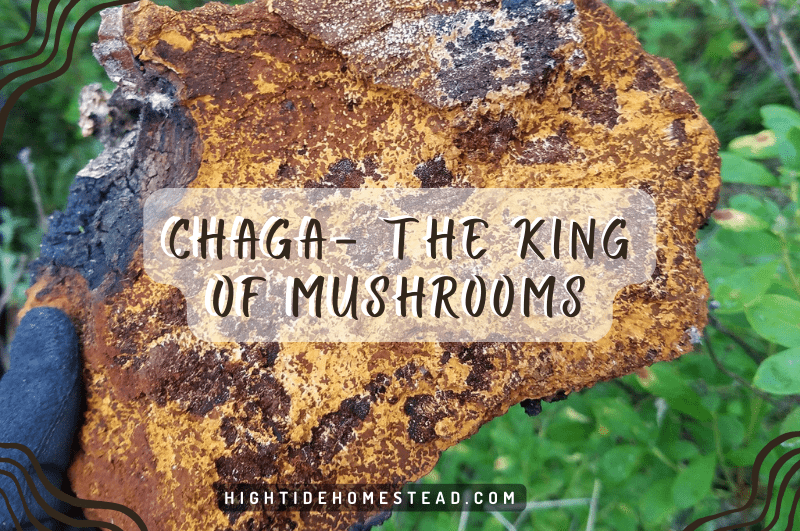High Tide Homestead participates in affiliate programs and may earn commissions from qualifying purchases on this post. See our Disclosure page for more information.
Have you ever heard of Chaga?
I hadn’t until I moved to this area. Chaga, also known as the King of Mushrooms, is a type of parasitic fungi that is found primarily in birch trees. Luckily, we are surrounded by birch here on our property. Chaga is well known folk remedy for many illnesses including cancers, cardiovascular diseases and diabetes. People also swear by it as the reason for their longevity. And it helps that it doesn’t taste bad either, as it’s slightly vanilla flavored. There are several hospitals now conducting studies on this mushroom and how it affects the human body. We were told about it by our friends, and they took Kyle and I hunting for it so we would be able to identify it ourselves.

Chaga is an interesting-looking fungi that could easily be confused with a burl on a tree.
It looks like a spot where the tree has been injured and burned. The outer shell is hard, rough and black, while the inner portion is also hard. It is more of a burnt orange color.

It is easy to miss when until you find a few pieces, then it seems like it’s everywhere, at least around here anyway! Chaga is best harvested in the fall and winter when it has stored the most nutrients from its host tree. It must be cut carefully away from the tree. Birch trees can actually “bleed” to death, so damage to the tree must be avoided. Leaving a small piece of Chaga attached to the tree will also allow it to grow back, where it can be harvested again in several years. Pieces smaller than a baseball should be left to grow another year before harvesting. While Chaga is a parasite and will eventually kill its host tree, it takes years to do so.
To use Chaga most people make a tea out of it.
It shouldn’t be heated to boiling, as this will produce a burnt flavor. Chaga can be ground up or simply broken into chunks and steeped in hot water. Chaga tea also tastes good when it is cooled or refrigerated. Kyle and I both tried it and liked it. We plan on harvesting more from our property this fall and winter!
High Tide Homestead participates in affiliate programs and may earn commissions from qualifying purchases on this post. See our Disclosure page for more information.
